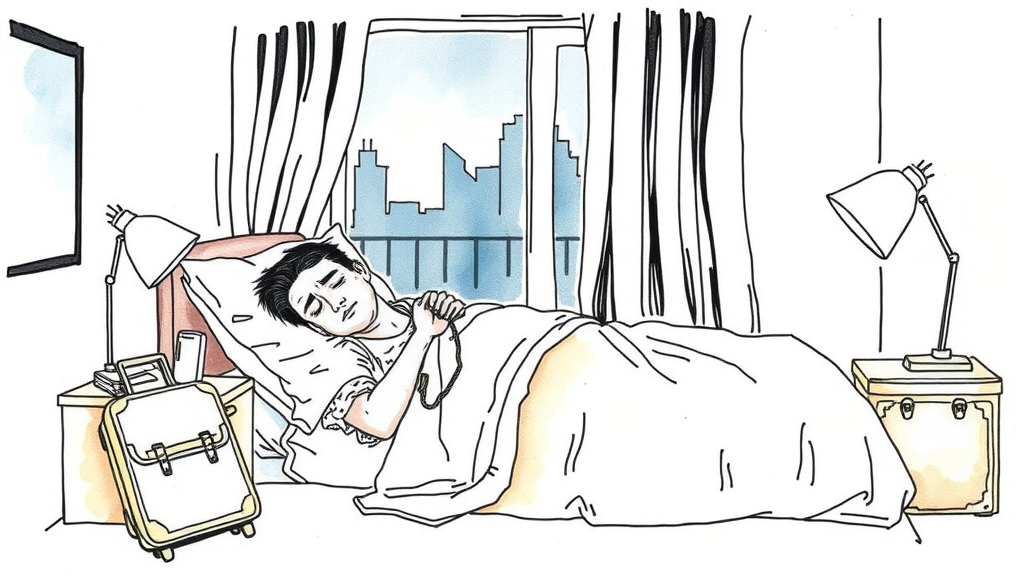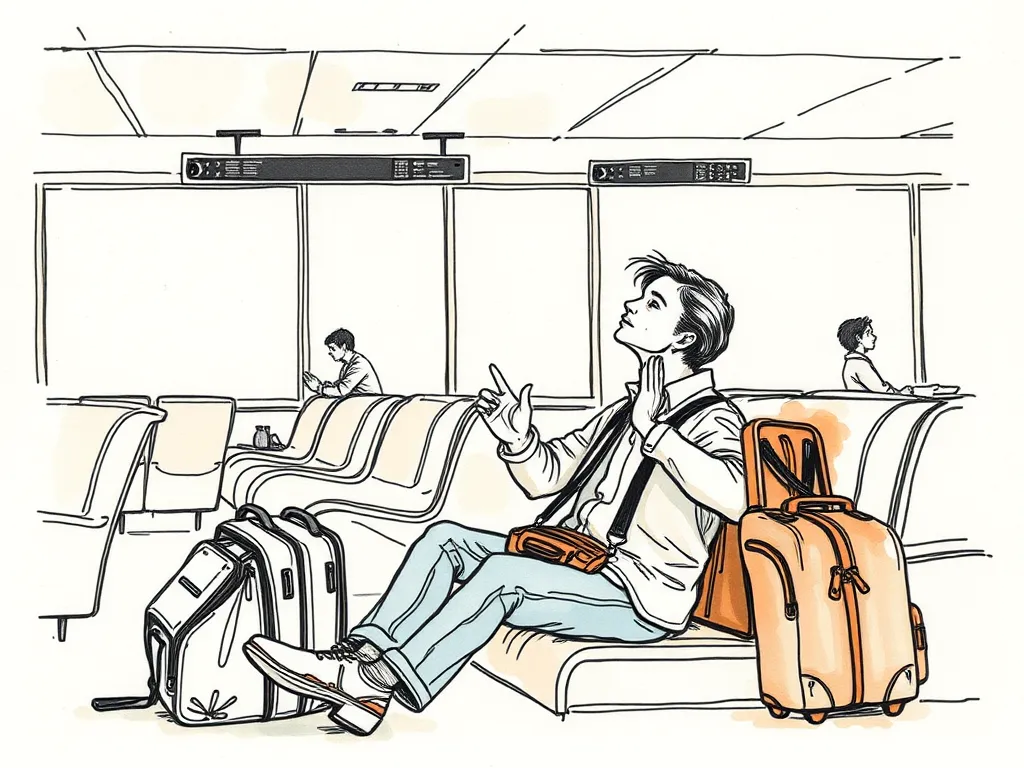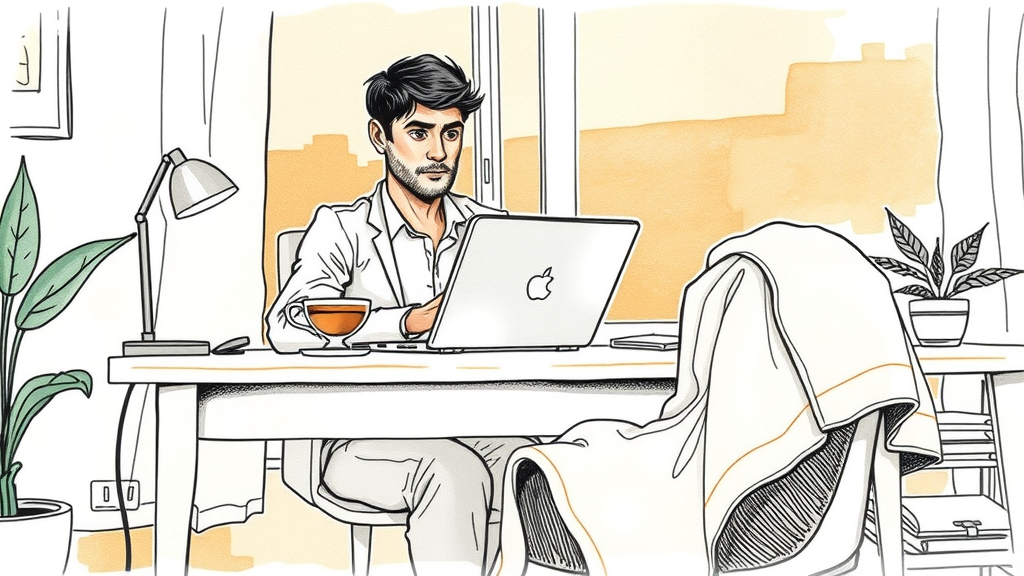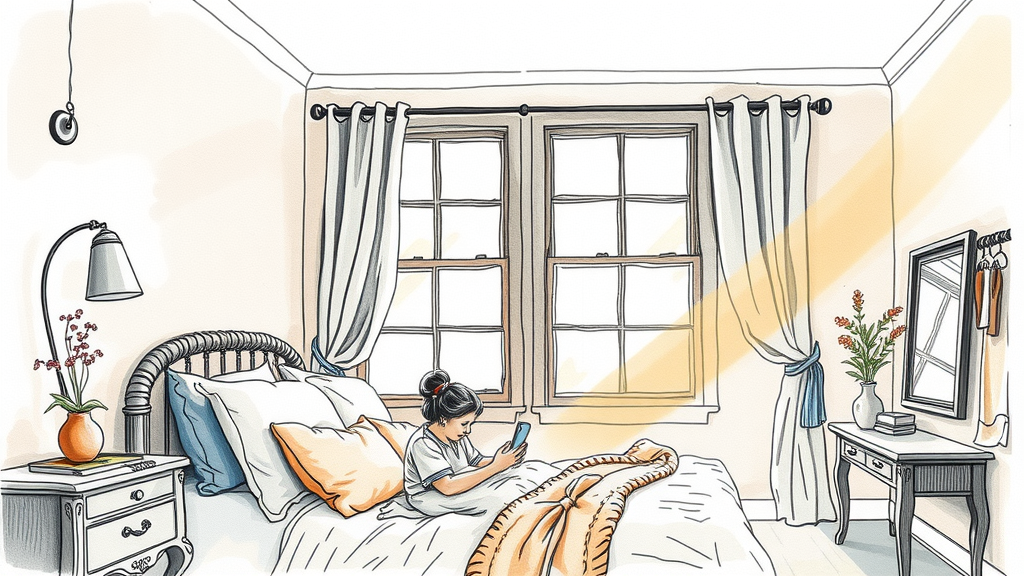· Sleep Health Specialist · Travel Wellness · 15 min read
The Ultimate Guide to CBTI Sleep Therapy for Frequent Travelers
Frequent traveler struggling with sleep? Discover how CBTI, a drug-free sleep treatment, can offer lasting insomnia relief and improved rest.

Navigating Sleep Challenges as a Frequent Traveler
For the modern frequent traveler, the world is an oyster – but it often comes with a significant trade-off: consistent, restorative sleep. From navigating different time zones and unpredictable schedules to sleeping in unfamiliar hotel rooms and dealing with the constant buzz of airports, maintaining healthy sleep habits can feel like an impossible mission. The cumulative effect of these disruptions often leads to insomnia relief challenges, leaving travelers feeling perpetually tired, less productive, and prone to illness. While many might reach for quick fixes, there’s a growing awareness of more sustainable, drug free sleep treatment options.
Enter Cognitive Behavioral Therapy for Insomnia, or CBTI. This evidence-based sleep therapy has emerged as the gold standard for treating chronic insomnia, and its principles are remarkably adaptable for those constantly on the move. Unlike temporary solutions, CBTI equips individuals with strategies to reframe their thoughts and behaviors around sleep, addressing the root causes of their sleep difficulties rather than just masking the symptoms. For travelers, this means learning to navigate jet lag, optimize sleep environments in diverse locations, and build resilience against travel-induced sleep disruptions. This comprehensive guide will explore how CBTI can transform your travel experience, helping you achieve consistent, quality sleep no matter where your journey takes you.
Understanding the Traveler’s Sleep Dilemma
Frequent travel introduces a unique set of obstacles to healthy sleep. The human body thrives on routine, and travel inherently disrupts it. Here are the primary culprits:
- Jet Lag: The most obvious offender. Crossing time zones throws your circadian rhythm – your internal body clock – into disarray. Your body expects it to be night when it’s day, and vice-versa, leading to fatigue, disorientation, and severe sleep disturbances.
- Unfamiliar Environments: Sleeping in different beds, with varying light, noise, and temperature conditions, can make it difficult to relax and fall asleep. Hotel rooms, airplanes, and even friends’ spare rooms rarely offer the comfort and familiarity of home.
- Disrupted Routines: Meal times, exercise schedules, and even social interactions shift. These daily anchors, which help regulate your body clock, become inconsistent.
- Travel Stress and Anxiety: The logistics of travel – missed flights, tight connections, work pressures, or personal obligations – can heighten anxiety levels, making it harder to unwind and achieve
insomnia relief. - Dietary Changes: Irregular eating patterns, consuming unfamiliar foods, or relying on stimulants like caffeine to combat fatigue can further interfere with sleep architecture.
These factors collectively contribute to a pattern of poor sleep that, if left unaddressed, can lead to chronic insomnia relief issues, impacting mental clarity, physical health, and overall well-being. This is where CBTI offers a powerful and enduring solution.
What Exactly is CBTI?
Cognitive Behavioral Therapy for Insomnia is a structured program that helps individuals identify and replace thoughts and behaviors that hinder sleep with habits that promote it. It’s not a one-size-fits-all approach but a tailored set of techniques that address the specific factors contributing to an individual’s insomnia. Unlike sleep medications, CBTI is a drug free sleep treatment that focuses on equipping you with lifelong skills.
The core components of CBTI include:
- Cognitive Restructuring: This addresses the mental component of insomnia. Many people with sleep difficulties develop unhelpful thoughts and beliefs about sleep (e.g., “I’ll never get a good night’s sleep,” “I need 8 hours to function”). Cognitive restructuring helps identify these thoughts and challenge them, replacing them with more realistic and positive ones. For travelers, this might involve reframing worries about jet lag or unfamiliar beds.
- Behavioral Strategies: These are practical techniques designed to improve sleep habits and regulate the sleep-wake cycle:
- Sleep Restriction: Paradoxically, this involves temporarily reducing the time spent in bed to increase sleep drive and consolidate sleep. It helps synchronize your body clock with your actual sleep patterns. For travelers, this is crucial for adapting to new time zones.
- Stimulus Control Therapy: This aims to re-associate the bed and bedroom with sleep and relaxation, not with wakefulness, worry, or activities like working or watching TV. It involves going to bed only when sleepy and getting out of bed if unable to sleep.
- Sleep Hygiene Education: This provides general guidelines for healthy sleep habits, such as maintaining a consistent sleep schedule, creating a comfortable sleep environment, avoiding caffeine and alcohol before bed, and incorporating regular exercise. While often the first recommendation for sleep issues,
CBTIgoes much deeper than just sleep hygiene.
- Relaxation Techniques: Learning techniques like progressive muscle relaxation, diaphragmatic breathing, or mindfulness can help reduce the physiological arousal that often accompanies insomnia.
By integrating these components, CBTI provides a holistic framework for achieving sustainable insomnia relief, making it an ideal sleep therapy for the challenges of frequent travel.
Why CBTI is the Ideal Sleep Solution for Travelers
Given the unique pressures faced by those who travel frequently, CBTI stands out as an exceptionally suitable sleep therapy. Its inherent strengths align perfectly with the needs of a dynamic lifestyle:
- Drug-Free and Sustainable:
CBTIis adrug free sleep treatment, meaning no side effects, no dependency risks, and no need to pack different medications for different time zones. The skills learned are lifelong and transferable, offering permanentinsomnia reliefrather than a temporary fix. - Addresses Root Causes: Instead of merely masking symptoms,
CBTItackles the underlying cognitive and behavioral factors contributing to sleep problems. For travelers, this means developing resilience against jet lag, managing anxiety about unfamiliar beds, and establishing flexible sleep routines. - Adaptable to Changing Environments: The principles of
CBTIare highly adaptable. Whether you’re in a noisy hotel in a bustling city or a quiet guesthouse in the countryside, you can apply stimulus control, optimize sleep hygiene, and manage your thoughts about sleep. This flexibility is paramount for a transient lifestyle. - Empowerment and Self-Efficacy:
CBTIputs you in the driver’s seat. You learn to be your own sleep expert, equipped with the tools to manage sleep disturbances independently. This sense of control is invaluable when your environment is constantly changing. - Improves Daytime Functioning: By improving sleep quality,
CBTIleads to significant improvements in daytime alertness, mood, concentration, and overall performance, which are critical for productive business trips or enjoyable leisure travel. For instance, similarCBTI strategies for athletes who face demanding scheduleshighlight the therapy’s ability to enhance performance through better rest. - Long-Term Results: Studies consistently show that the benefits of
CBTIare durable, often outlasting those of sleep medications. For someone whose profession or lifestyle involves ongoing travel, this long-terminsomnia reliefis incredibly valuable.
Core CBTI Components Tailored for the Frequent Traveler
Let’s delve into how the main components of CBTI can be specifically applied to mitigate the unique sleep challenges of frequent travel.
1. Sleep Restriction Therapy: Mastering Time Zone Transitions
While the name sounds counterintuitive, sleep restriction helps consolidate sleep and strengthen the drive to sleep. For travelers, this technique is particularly powerful for adapting to new time zones.
- Strategic Adjustment: Instead of trying to sleep immediately upon arrival, gradually shift your bedtime and wake-up time over a few days before your trip. Once you arrive, try to align your sleep schedule with the local time as quickly as possible, even if it means staying awake longer than usual initially.
- Controlled Wakefulness: If you arrive and it’s daytime, avoid naps, or keep them very short (20-30 minutes power naps) to build up sleep pressure for the night. This is key to forcing your body clock to adjust.
- Consistency (Relative): Once you’ve adjusted, try to maintain a consistent wake-up time, even on weekends or days off, to stabilize your circadian rhythm. This can be challenging for those who travel extensively or are managing sleep across irregular hours, similar to challenges faced by shift workers.
2. Stimulus Control Therapy: Reclaiming the Hotel Bedroom
Stimulus control aims to break the association between your bed/bedroom and activities that promote wakefulness or anxiety. For travelers, this means making the hotel room a sanctuary for sleep.
- Bed for Sleep Only: Use the hotel bed exclusively for sleep and intimacy. Avoid working, eating, or watching extended TV in bed. If you must work in your room, do so at a desk or in a chair.
- Leave the Bed if Awake: If you find yourself unable to sleep after 15-20 minutes, or if you wake up in the middle of the night and can’t fall back asleep, get out of bed. Go to another part of the room and engage in a quiet, non-stimulating activity (reading a physical book, gentle stretching) until you feel sleepy again, then return to bed.
- Consistent Pre-Sleep Routine: Develop a short, relaxing routine that signals to your body it’s time to wind down, regardless of location. This could be reading, listening to calm music, or taking a warm bath if available. This routine should be portable.
3. Cognitive Restructuring: Calming Travel-Induced Sleep Anxiety
Travel can heighten anxiety, and for many, this anxiety extends to worrying about sleep itself, creating a vicious cycle. Cognitive restructuring helps challenge these unhelpful thoughts.
- Identify Negative Thoughts: Recognize common thoughts like “I’ll be exhausted for my meeting,” “I’ll never adjust to this time zone,” or “I can’t sleep in this noisy hotel.”
- Challenge and Reframe: Ask yourself if these thoughts are truly accurate or helpful. Replace them with more balanced perspectives: “I’ll do my best to adjust, and even a little sleep is better than none,” “I can control my reaction to noise,” or “I have tools to manage this.” Remember that CBTI’s effectiveness in managing anxiety-induced insomnia is well-documented, and these same principles apply to travel-related anxieties.
- Mindfulness and Acceptance: Learn to acknowledge anxious thoughts without judgment, and gently redirect your focus to the present moment or a relaxation technique. Accept that some travel nights might be less than perfect, but that doesn’t mean you’ll be incapacitated.
4. Sleep Hygiene Adapted for the Road
While CBTI goes beyond basic sleep hygiene, these principles remain foundational and require special consideration for travelers.

- Optimize Your Sleep Environment (Wherever You Are):
- Darkness: Pack an eye mask. Use blackout curtains if available, or improvise with clips or tape.
- Quiet: Use earplugs or a white noise app/machine to block out hotel noise.
- Temperature: Adjust the thermostat. Aim for a cool, comfortable temperature (around 65°F/18°C).
- Manage Light Exposure: Maximize exposure to natural light during the day in your new time zone. Minimize bright light (especially blue light from screens) in the hours leading up to bedtime.
- Strategic Eating and Drinking: Avoid heavy meals, excessive caffeine, and alcohol close to bedtime. Hydrate well, but limit liquids a few hours before sleep to avoid waking for bathroom breaks.
- Exercise (Timely): Regular physical activity improves sleep, but avoid intense workouts too close to bedtime. A brisk walk during the day can help solidify your new time zone.
5. Relapse Prevention and Flexibility
CBTI also prepares you for inevitable occasional poor nights of sleep. For travelers, this is crucial as disruptions are a given.
- Expect Fluctuations: Understand that not every night will be perfect, especially when traveling. Don’t let one bad night derail your efforts.
- Reinforce Strategies: When you return home or have a stretch of stable travel, reinforce your
CBTIstrategies to maintain your sleep gains. - Portable Toolkit: Mentally or physically pack your
CBTItoolkit: eye mask, earplugs, relaxation exercises, and cognitive reframing techniques.
Implementing CBTI in Your Travel Routine
Integrating CBTI into a life of frequent travel requires foresight and commitment. Here’s a practical guide:
Before You Go:
- Pre-Adjust Gradually: For long-haul flights across multiple time zones, start shifting your sleep schedule by 15-30 minutes per day towards your destination’s time zone for a few days before departure. This significantly reduces jet lag impact.
- Pack Smart for Sleep: Include your sleep essentials: eye mask, earplugs, a portable white noise machine or app, comfortable travel pajamas, and any familiar sleep aids like a favorite pillowcase or essential oil roller.
- Plan Your Arrival: Research your accommodation for sleep-friendly features. Note local sunset/sunrise times. Plan your first day to maximize light exposure during waking hours.
During Travel:
- On the Plane: If it’s nighttime at your destination, try to sleep on the plane. Use your eye mask, earplugs, and neck pillow. Avoid excessive alcohol or caffeine. If it’s daytime, stay awake and engage in stimulating activities.
- Upon Arrival – Embrace the New Time: As soon as you arrive, set your watch to local time. Expose yourself to natural light. Eat meals at local times. Resist the urge to nap for too long, or at all, if it’s daytime.
- Create Your Sleep Sanctuary: Upon entering your hotel room, immediately address light, noise, and temperature. Dim lights, use blackout curtains, deploy earplugs/white noise, and adjust the thermostat.
- Stick to Your Routine (as much as possible): Even a modified bedtime routine can help. Take a warm shower, read a book, listen to a podcast, or do some gentle stretches.
After Travel:
- Re-align Quickly: Once home, immediately revert to your regular sleep schedule. Prioritize consistency.
- Reflect and Adjust: Note what worked and what didn’t. Each trip is an opportunity to refine your
CBTIstrategies. For those navigating challenging personal circumstances, such as CBTI can offer significant relief, much like its benefits for caregivers who face similar disruptions to routine and sleep.
Common Challenges and CBTI Solutions for Travelers
Even with CBTI tools, travel presents unique hurdles. Here’s how to address them:

- Challenge: Unpredictable Schedules: Business meetings, flight delays, or social obligations can throw off your carefully planned sleep schedule.
- Solution: Focus on flexibility. If you can’t maintain your exact sleep window, prioritize a consistent wake-up time. Use napping strategically (short power naps) to bridge gaps, rather than long naps that can disrupt nighttime sleep.
- Challenge: Noisy Hotel Rooms: Street noise, thin walls, or loud neighbors can prevent sleep.
- Solution: Earplugs are non-negotiable. A white noise machine or app (e.g., fan noise, ocean waves) can effectively mask unpredictable sounds. Ask for a quiet room away from elevators or street noise when booking.
- Challenge: Different Beds and Pillows: The unfamiliar feel can be unsettling.
- Solution: Bring a small, familiar comfort item like your own pillowcase or a comforting scent. Focus on relaxation techniques to help your body adapt. Remind yourself that discomfort is temporary and that your
CBTIskills will help you overcome it.
- Solution: Bring a small, familiar comfort item like your own pillowcase or a comforting scent. Focus on relaxation techniques to help your body adapt. Remind yourself that discomfort is temporary and that your
- Challenge: Travel Anxiety about Sleep: Worrying about whether you’ll sleep well on your trip can become a self-fulfilling prophecy.
- Solution: Employ cognitive restructuring. Acknowledge the anxiety, but don’t dwell on it. Focus on what you can control (your behaviors and environment), rather than what you can’t. Trust in your
CBTItraining.
- Solution: Employ cognitive restructuring. Acknowledge the anxiety, but don’t dwell on it. Focus on what you can control (your behaviors and environment), rather than what you can’t. Trust in your
Finding a CBTI Therapist for Travelers
While this guide provides a foundation, working with a trained CBTI therapist can significantly accelerate your progress and provide personalized strategies. For frequent travelers, finding a therapist doesn’t mean you need to be in the same city:
- Telehealth/Online CBTI: Many
CBTIspecialists offer virtual sessions, making it incredibly convenient for travelers. You can have consistent sessions regardless of your physical location. - Specialized Clinics: Some sleep clinics or therapists specialize in
CBTIfor specific populations, though finding one explicitly for travelers might be rare, their expertise in chronicinsomnia reliefis broadly applicable. - Digital CBTI Programs: Several reputable apps and online platforms offer structured
CBTIprograms. These can be excellent resources for those with very unpredictable schedules or who prefer a self-paced approach.
When seeking a therapist, look for someone specifically trained and certified in CBTI (often psychologists, licensed counselors, or medical doctors with additional sleep therapy certification). Their expertise will ensure you’re getting the most effective, evidence-based drug free sleep treatment.
The Journey to Restful Travel
Frequent travel doesn’t have to mean sacrificing your sleep. By embracing Cognitive Behavioral Therapy for Insomnia, you gain a powerful, drug free sleep treatment that addresses the unique challenges of a life on the go. CBTI empowers you with the knowledge and skills to understand your sleep, reframe unhelpful thoughts, and establish consistent, sleep-promoting behaviors, regardless of your time zone or temporary accommodation.
Investing in CBTI is an investment in your health, productivity, and enjoyment of both your travels and your life back home. Say goodbye to the endless cycle of travel fatigue and hello to sustainable insomnia relief. Your adventures await, and now, so does truly restorative sleep.
Frequently Asked Questions (FAQ)
Q1: Is CBTI effective for immediate jet lag relief?
A1: While CBTI teaches strategies to minimize jet lag over time (like light exposure and sleep restriction techniques), it’s not an instant cure for the immediate disorienting effects. Its strength lies in helping your body adapt faster and preventing chronic sleep issues from recurrent travel.
Q2: How long does it take for CBTI to work for a frequent traveler?
A2: Significant insomnia relief improvements are often seen within 4-8 weeks of consistent CBTI practice. For frequent travelers, the learning curve might involve more active adaptation, but the underlying skills are quickly acquired. The long-term benefits are sustained with continued application of the techniques.
Q3: Can I combine CBTI with sleep medication while traveling?
A3: CBTI is often recommended as a drug free sleep treatment. However, if you are currently using sleep medication, it’s crucial to discuss its use with your doctor and a CBTI therapist. They can guide you on safely tapering off medication as CBTI skills become effective, or how to use it sparingly for extreme circumstances while still prioritizing behavioral changes.
Q4: Are there specific apps or digital tools for CBTI for travelers?
A4: Yes, several apps (like Sleepio, Calm, or Headspace which offer some CBTI-informed content) and online platforms offer structured CBTI programs that can be accessed anywhere. Look for programs specifically designed by sleep experts and based on CBTI principles, offering guided exercises and tracking tools to help you stay consistent while on the road.
Q5: What if my travel schedule is highly erratic and unpredictable?
A5: While consistency is key in CBTI, the therapy also emphasizes flexibility. For highly erratic schedules, focus on the core principles: maintaining a consistent wake-up time whenever possible, optimizing your sleep environment, using stimulus control, and applying cognitive restructuring to manage sleep anxiety. Even small consistent efforts will yield benefits, and the ability to adapt is a core strength of CBTI for frequent travelers.
Assess Your Sleep Quality Today
Take our My Sleep Health Score assessment to get personalized insights about your sleep patterns and discover how CBT-I can help you achieve better sleep.

Don Schmidt
15+ years of experience in sleep therapy and Cognitive Behavioral Therapy for Insomnia (CBT-I). Passionate about connecting individuals struggling with sleep disorders to evidence-based, non-medical treatment solutions. Author of hundreds of articles and comprehensive guides on sleep health, CBT-I techniques, and overcoming insomnia. When not helping clients achieve better sleep, you can find me hiking with my family and dogs or enjoying a good book.
Ready to connect with a provider?
Allow us to connect you with a provider who can help.


